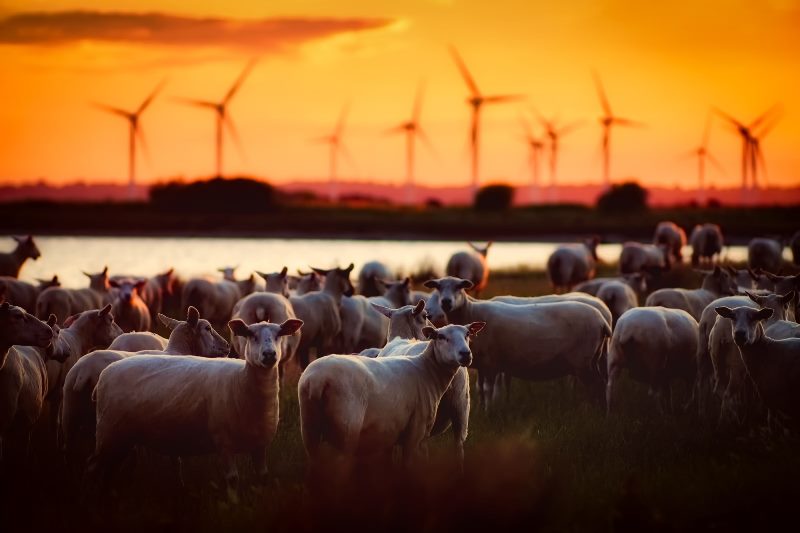By John Young
The Big Five is a well-known concept describing the most sought-after game animals to be spotted on safari. The Eastern Cape is moving towards an economic equivalent, where five sectors will underpin the provincial economy. For many years the Eastern Cape has relied on two giants to drive growth: agriculture and the automotive industry.
The latest trends suggest that three other sectors are playing an important role in advancing economic progress in the coastal province: the maritime sector (including oil and gas and logistics); renewable energy (primarily wind); and an expanded tourism sector.
Historically, wool and ostrich feathers were the region’s first exports and these items are still in the export basket (with wool more prominent than ostrich feathers). In time, the Eastern Cape also became a global leader in mohair, the luxury fibre taken from Angora goats. This position has strengthened in recent years. The fertile Langkloof Valley in the west has enormous deciduous fruit orchards and the Alexandria and Grahamstown area produces pineapples, chicory and dairy products. The Eastern Cape is the leading livestock province in terms of numbers of sheep and cattle and produces a quarter of South Africa’s milk.
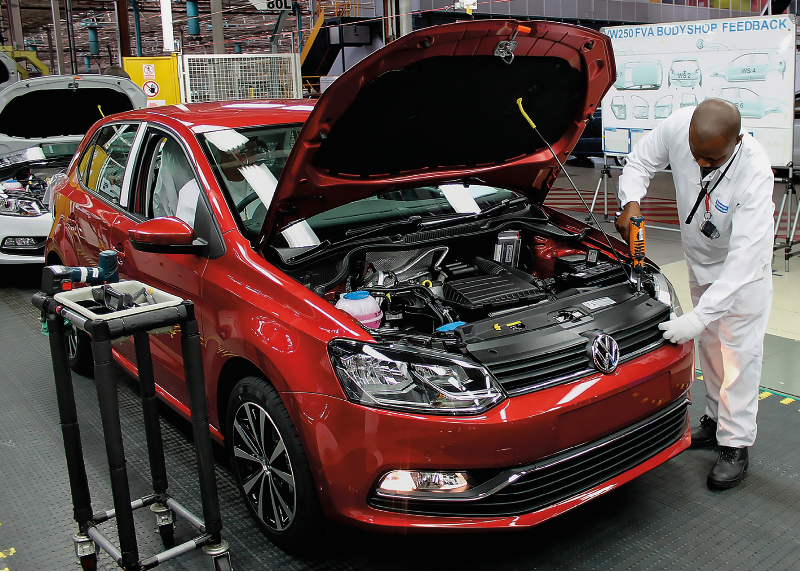
The manufacturing facilities of Volkswagen South Africa (in Uitenhage) and Mercedes-Benz South Africa (East London) are at the core of the province’s important automotive sector. It was to support this sector that industrialisation took place in the province. Smelters and metal works were built to service car makers and automotive component manufacturers. Ford engines are built in Port Elizabeth and a wide range of makers of automotive glass, catalytic converters, vehicle tyres and other parts are found in Uitenhage, Port Elizabeth and at the Industrial Development Zone (IDZ) in East London (ELIDZ).
New investments into this sector are coming from both international and local investors. Two Chinese car makers have recently invested in the Coega IDZ, First Automotive Works (FAW) and Beijing Automobile Corporation (BAIC). Local giants Volkswagen SA and Mercedes-Benz SA have invested heavily in increased capacity for new lines of production.
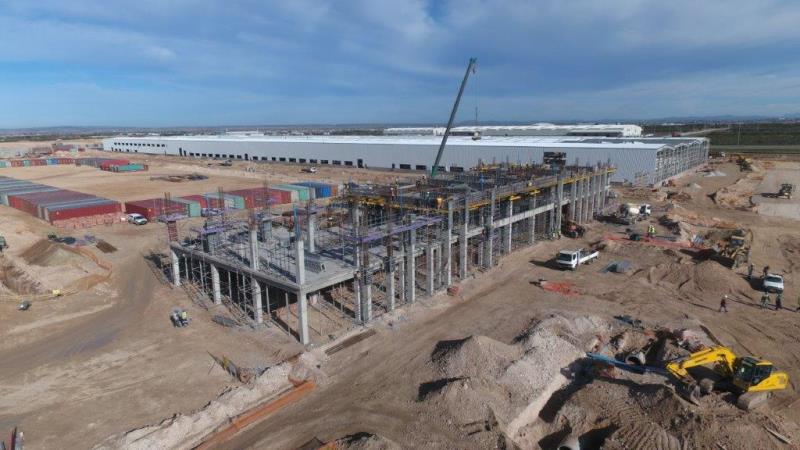
New impetus
The sectors identified above have all received significant boosts in recent months.
In the maritime sector, or Oceans Economy, national government has named the Coega IDZ as the site for a 1 000 MW Liquefied Natural Gas (LNG) plant. The value to the regional economy of the project is estimated at R25-billion. A gas-fired power plant (Dedisa) started operating at Coega in 2016, and there are plans to expand this sector.
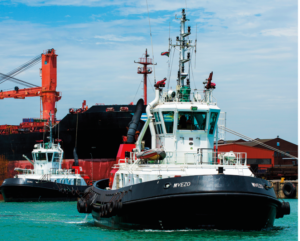
Since the company Aegean Bunkering Marine Services was licensed in 2016 by the South African Maritime Safety Authority (SAMSA) and Transnet to supply bunker fuel to ships passing through Algoa Bay, an additional 845 ships have used these services, adding more than R70-million to the local economy.
With the purchase by large companies like Statoil from Norway of a significant stake in exploration rights off the coast of the province, interest in offshore drilling is picking up. ExxonMobil is the approved operator of the Transkei-Algoa licence area, which covers about 45 000 km². Statoil is in another partnership with OK Energy in another field. Exploration activity will mean more work on the maintenance and supply of ships in East London and Port Elizabeth.
The launch of a specialist Ocean Sciences Campus at the Nelson Mandela University is another factor supporting the growth of maritime activities.
The renewable energy sector is similarly supported by educational institutions in the province, which provide research and skilled graduates who can take up jobs in the sector. The University of Fort Hare is studying biogas as a possible fuel for public transport, in partnership with the United Nations Industrial Development Organisation and United States Agency for International Development.
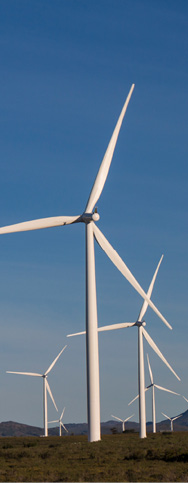
The Eastern Cape has become the country’s top site for wind farms and the East London IDZ, using turbines made by a local manufacturer, Adventure Power, aims to bolster supply security with its own 1.8 MW wind farm.
The overall picture for renewable energy in the province is positive, but there have been setbacks, not least in the closure of DCD Wind Towers, an Industrial Development Corporation-backed venture that was supposed to manufacture wind towers from its plant in the Coega IDZ. Uncertainty about the national independent producers’ programme led to the plant’s closure in 2016.
The Eastern Cape’s beaches and natural beauty have been attractive to tourists for many years, but recent initiatives to expand the province’s offerings are paying off. With a focus on events and “adventure tourism”, visitor numbers are steadily growing. The province aims to be a “Top Three” domestic destination by 2020. Spending by tourists has grown from R2.4-billion in 2013 to R4.1-billion in 2015 and the average length of stay (5.3 days) is the best in South Africa.
Recent investments by the Eastern Cape Parks and Tourism Agency include the construction of a conference centre at the Cape Morgan Nature Reserve. The hosting of the 2018 IRONMAN 70.3 World Championship event is evidence that the strategy of attracting events to the Eastern Cape is working. There will be significant financial spin-offs from this international event.
Assets
The Eastern Cape extends over 169 580 square kilometres, representing 13.9% of South Africa’s land mass. The dry western interior is one of the country’s premier sheep-rearing destinations. The mountainous regions of the north and east of the province support timber plantations while the coastal belt in the south-west is well-watered and is good for dairy farming. The province has spectacular beaches stretching from the surfer’s paradise at Jeffreys Bay all the way to the famed Wild Coast.
Two major airports at Port Elizabeth and East London provide good air links and smaller towns such as Mthatha and Bhisho have airports. Mthatha has recently received upgrades and SA Express has added five direct flights per week to and from Cape Town.
The Umzimvubu Multipurpose Development Project is a large development plan that incorporates a multi-purpose dam to supply water for new irrigation, hydropower generation and domestic water supply.
The Eastern Cape Development Corporation is a development financier and it is supporting enterprises in the growing ICT and film sectors through the Eastern Cape Information Technology Initiative (ECITI).
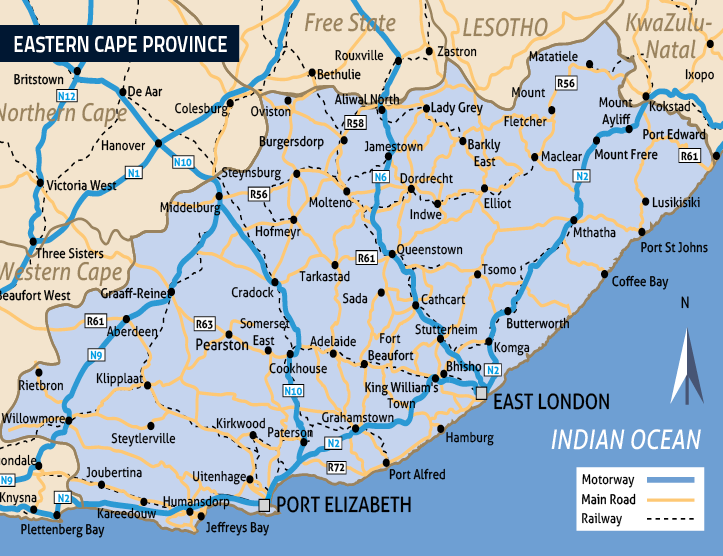
Alfred Nzo District Municipality
Towns: Matatiele, Mount Frere, Mount Ayliff
The smallest district is in the mountainous north-east, with hiking trails for tourists. There is scope for expansion of tourist activities, and a transfrontier park between South Africa and Lesotho could boost the area’s economy.
Subsistence agriculture and forestry are the major economic activities. There have been several investments in forestry in recent years.
Amathole District Municipality
Towns: Cathcart, Stutterheim, Morgan Bay, Willowvale, Butterworth, Mazeppa Bay, Alice, Bedford
The rural Amathole District surrounds the metropolitan area of Buffalo City. Pineapple and forestry are two of the most important agricultural activities. Popular resorts on the Wild Coast attract many tourists to the area. Hogsback and other towns near the Amatole Mountains offer beautiful scenery and popular beaches. The main campus of the University of Fort Hare is located at Alice.
Sarah Baartman District Municipality
Towns: Graaff-Reinet, Humansdorp, Jeffreys Bay, Grahamstown
The western part of the province contains the biggest municipality and is one of the biggest contributors to provincial GDP. Large commercial farms in the Karoo produce high-quality meat, wool and mohair, while the coastal belt has dairy farming and some forestry. The Kouga Valley is a big deciduous fruit producer, while the Kirkwood/Addo area is known for its citrus. Sarah Baartman has three of the region’s national parks and several private game farms. Grahamstown hosts the National Arts Festival, Rhodes University and several fine schools.
Chris Hani District Municipality
Towns: Middelburg, Molteno, Dordrecht, Cradock, Queenstown, Lady Frere, Elliot
Sheep farming is an important part of the economy. Some coal is found in the north and tourist activities include fly-fishing. The Foodcorp factory in Molteno manufactures Ouma rusks. Queenstown is a centre for cattle farming and has some manufacturing activities. The Mountain Zebra National Park is near Cradock. The Grootfontein Agricultural College and Research Station is in Middelburg, and the Marlow Agricultural College is near Cradock.
OR Tambo District Municipality
Towns: Mthatha, Coffee Bay, Port St Johns, Qumbu, Bizana, Flagstaff
OR Tambo District Municipality encompasses some of the province’s least-developed areas and contains one of South Africa’s most important ecological areas, the Pondoland Centre of Plant Endemism. Mining is already pursued in some areas but plans for titanium mining on seaside dunes are being contested. A Wild Coast Spatial Development Initiative exists to plot further development. Forestry is a big employer.
Joe Gqabi District Municipality
Towns: Aliwal North, Burgersdorp, Lady Grey, Rhodes, Barkly East, Ugie
Cattle and sheep farming make up 80% of land use, while commercial forestry is a big contributor to employment. There are large forestry plantations at Ugie and Mount Fletcher. Maize is grown along the Orange River and wheat in the foothills of the Drakensberg mountains. Tiffindell has been revived as a ski resort.
Quick facts:
- Capital: Bhisho
- Major cities: Buffalo City Metropolitan Municipality (Bhisho, East London and King William’s Town) and Nelson Mandela Bay Metropolitan Municipality, (Port Elizabeth and Uitenhage)
- Languages: 78.8% isiXhosa, 10.6% Afrikaans, 5.6% English
- Population: 6.9-million
- Share of total South African population: 12.7%
The province’s population of 6.9-million makes it the country’s third most populous province, with about 15% of the national population.

